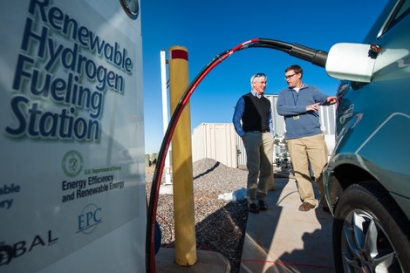
The research paper ‘Hydrogen in the electricity value chain’ concludes that production of hydrogen from electrolysis will become competitive with production from natural gas. The paper also finds that as renewable capacity increases, opportunities to utilise low-cost electricity for green hydrogen applications will become feasible over the next 16 years. Peak electricity generation with hydrogen could provide a viable additional hydrogen market.
The results provide an encouraging outlook for the acceleration of the energy transition, as hydrogen is a unique energy carrier with no carbon emissions that can be used for long-term storage and heating applications. By using electricity generated from renewable sources such as wind and solar energy, the resulting energy carrier is carbon-free ‘green’ hydrogen
The economically viable use of green hydrogen becomes feasible due to the increasing penetration of wind and solar power in the years to come. DNV GL’s Energy Transition Outlook forecasts that solar PV, wind energy and hydropower will account for 80 percent of global electricity production in 2050. As this capacity increases, opportunities to utilise its low-cost electricity are becoming feasible to avoid curtailment: initially conversion into heat then (daily) battery storage and eventually conversion into green hydrogen.
The prerequisites for hydrogen to become an economically viable energy carrier are two-fold:
Firstly, the prospect of increasing times with low-cost electricity caused by an oversupply of available energy due to the sharp rise of renewable energy sources.
Secondly, use cases for hydrogen applications are expected to be in support of low-carbon options. If those parameters are set, the production of hydrogen from electricity can compete with natural-gas based hydrogen production and provides a viable commercial business option for numerous applications, starting with industrial hydrogen feedstock.
DNV GL’s energy experts conclude that the main reasons for the economic feasibility of hydrogen between 2030 – 2050 are driven by three key developments:
The cost of electrolysers will go down caused by learning curve experiences and the cost of asset developments which is expected to decrease. Production by electrolysis from ‘surplus’ or low- cost electricity from renewables is an option for producing low-carbon hydrogen with no related carbon emissions.
Time periods when low or zero cost prices for electricity are available will increase due to the rise of renewables, generating a surplus of energy available to the power grid.
Penalisation of carbon emissions In the coming years industries are expected to see a shift away from carbon-heavy activities, for example due to introduction of carbon tax and incentives for low carbon solutions.
“The prospect of delivering affordable hydrogen applications in the mid-term future provides a very encouraging signal to accelerate the global energy transition” said Lucy Craig, Vice President of Technology and Innovation at DNV GL – Energy. “Our research demonstrates that green hydrogen provides an optimal use for surplus electricity, which we expect to see in the years to come due to the rapid rise of renewable energy. In combination with electrolysis, hydrogen proves to be an economically feasible solution for the decarbonisation of the heat and storage sector.”
DNV GL’s researchers made a distinction between hydrogen production using surplus electricity generation from renewables and peak electricity generation, applying hydrogen as a fuel. This distinction is based on the underlying belief that the role of hydrogen in the electricity system competes with alternative solutions to the challenges of the energy transition and the increasing penetration of variable renewable energy systems.
For additional information:

